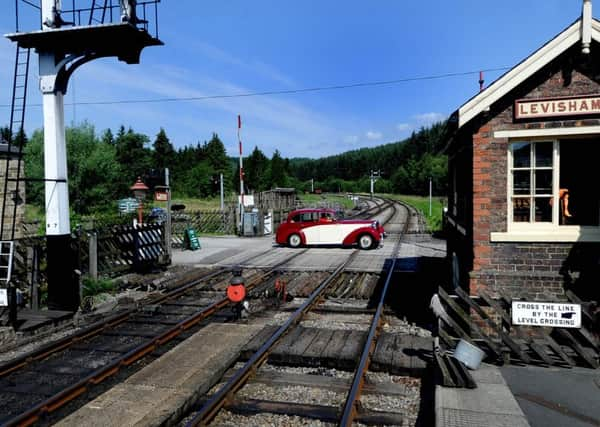Your Day Out: Walk full of surprises


Access to the starting point is from Thornton-le-Dale. Head north from the Buck Inn towards Whitby, but only as far as the Fox and Rabbit Inn, prominently sited to your right at the road junction. Here turn right along the A169 Whitby Road, After about a mile, turn left along Hostess Lane as signed to Levisham. You’ll then pass Moorland View Boarding Kennels off left.
Entering Lockton you’ll discover a village of the moors, set on a hill above a deep glen, with old cottages and farms. The YHA is to your right, and the village church immediately beyond.
Advertisement
Hide AdAdvertisement
Hide AdStart from Lockton’s quaint, grey church, with a 15th century tower and medieval nave and chancel. Continue to the triangular green, and almost opposite, to your left, seek between cottages an old well. It’s behind metal rails, but is sadly neglected. Seek a plaque on the side of the adjacent house which commemorates the building of a well in 1697. The names of the benefactors were recorded on here, but are now partly obscured by foliage etc.
On this dry upland plateau, water was a precious commodity and a pumped storage tank supplied water to the village. Continue past the telephone kiosk to the crossroads. To your left is Lockton Tea Room and Gallery, which re-opened on February 11. Ideal for a cuppa! Then veer right along Mill Bank Road as signed to Levisham 1.5 miles. A street map welcomes you to Lockton, and a cascade of snowdrops on the left bank, herald spring as you follow the steep lane into the valley bottom. Immediately over the bridge, view the delightful water mill and the wheel by which flows the musical Levisham Beck.
It no longer grinds the area’s wheat, but is a very pleasant private dwelling. Nearby is a small waterfall, and down the stream is the hidden, isolated church of St Mary. The Danish sculpture here dates from the late 10th century when Norse culture remained strong in this area. The small church is hemmed in by hills which rise like ramparts, and are draped with trees and heather.
Entering Levisham, one is immediately impressed by its superb setting. Perched on the edge of a moorland plateau there are many tumuli and earthworks, and stunning views! This village has a wide main street with grassed verges fronting houses on both sides. It has the classic lay-out of a planned medieval village.
Advertisement
Hide AdAdvertisement
Hide AdPassing the village hall to the left, you face the impressive Horseshoe Inn at the top, and a spacious lawn which is popular in summertime. Facing the inn, fork left along Braygate Lane as signed to Levisham Station 1.5 miles.
Just ahead (near a tree) you shortly fork left again along Braygate Balk, with dry stone walling either side. Beyond a cattle grid, drop steeply into the valley bottom, with an elevated bank of golden gorse bushes to your right, and a herd of long-horned Highland cattle in the area. The views are tremendous as you descend the track all the way to Levisham Station, with sheep maybe your sole companions!
Levisham Moor provides splendid views over Newtondale. This area was covered by forest about 5,000 years ago, and is now owned and managed by the National Park Authority. For centuries the moors have been grazed by sheep, and today sheep farming and management for grouse shooting continue to maintain the landscape. From October to March, small areas of heather are burned on an eight to 15 year cycle to create a mosaic of heather of various heights. This provides a habitat for nesting and feeding birds such as red grouse, golden plover and lapwing. If the moorland wasn’t managed, it would return to woodland.
Your track sweeps left along the bridleway leading to Levisham Station. The North Yorkshire Moors Railway opened in 1836 when Raindale New Inn was the ideal spot to pause for a drink on the two-hour journey between Pickering and Grosmont.
Advertisement
Hide AdAdvertisement
Hide AdNow take a look at Levisham Station, with its slate roofs and over-hanging eaves of station buildings. Slate was transported from North Wales or the Lake District by the railways. Levisham village is out of sight, some 1.5 miles south-east of the station and about 300ft from the valley floor!
The railway, in its early years relied on horses to pull the carriages. Here, a new pair of horses was harnessed to haul the train up to the summit. On the downhill trip to Pickering the horses were unhitched. They were put in a dandy cart behind the carriages and had a much easier time.
You may wish to wander footpaths beyond Levisham Station into Newtondale where routes abound.
Returning to Lockton by re-tracing your steps, the scene is quite a contrast in reverse!
Advertisement
Hide AdAdvertisement
Hide AdDistance: Six miles for the return route (or three miles if started from Levisham).
Refreshment: The Horseshoe Inn, Levisham, or Lockton Tea Room and Gallery, Lockton.
l The entire route is ideal for motorists, cyclists and bikers alike.